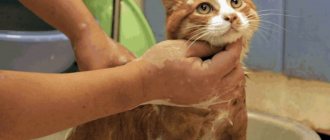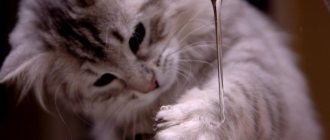Such an important process in caring for cats as washing them sometimes turns into complete drama. It is very important to wash your kitten correctly the first time. If you manage to bathe him without any problems, then you can count on a procedure that is, if not your favorite, then at least tolerable. And in some cases, try to turn bathing into a pleasant pastime.
If you wash the kitten incorrectly for the first time, then in the future you can forget about happy water activities. When the baby cannot be washed without stress, he will continue to flinch even at the sound of pouring water.
Optimal age for first bathing
Cats are excellent swimmers. Some varieties, such as the Turkish Van, love water and are willing to swim every day, this is due to the special structure of their coat. And the dislike of washing in most breeds is due to poor thermoregulation of these animals.
A wet cat, in addition to experiencing unpleasant sensations from the cold, is an easy prey for a hypothetical enemy, since it is helpless and its smell at this moment is too distinct. Therefore, the animal is in a hurry to shake the water off its fur and immediately dry itself with its rough tongue.
If the pet was purchased from a nursery, then there is no need to rush into the first bath. It is necessary to give the kitten time to get comfortable in the new home, because moving is a huge stress for the baby and it is not advisable to aggravate it.
But a kitten picked up on the street must not only be washed, but also treated for external parasites and dewormed if its health condition allows this.
Very small kittens, up to three months old, can simply be wiped with a wet sponge and combed.
Pedigree kittens, especially semi- or long-haired breeds, begin to be accustomed to water procedures from this age. This is especially true for Persian, Angora, and British cats.
If the animal is going to be exhibited, then it will have to be washed before each show, so it is important that this procedure becomes familiar and loved for the pet.
At what age can kittens be bathed?
To be absolutely clear: before this day, it is completely unacceptable to bathe kittens, and from now on, please, it is completely impossible. Circumstances vary.
The most common recommendation is not to bathe kittens that are not yet feeding on their own. The fact is that an unfamiliar smell will definitely alert the mother cat and she may completely refuse to feed the baby, or even begin to attack him. And what is the need to wash infants who are carefully licked by their mother? They all smell wonderfully like milk, baby and something cozy and homely.
A foundling is a completely different matter. If you pick up a baby on the street, he may be in a terrible state where it is simply impossible not to wash him. Yes, and such a kitten will have to be fed manually. So bathing will not harm him in any way. The main thing is to keep your baby warm until he is completely dry so that he doesn’t catch a cold.
A kitten purchased from a cattery is usually clean and well-groomed. In addition, not a single caring breeder will sell a baby before 3-4 months. It is at this age that the kitten has already received all the required vaccinations, he is quite independent and has learned all the skills necessary for living with a person: he goes to the litter box, uses a scratching post, eats neatly prepared food. So there is no need for an urgent bath. An exception may be when the kitten is traveling from afar. On the road, due to stress, he may go to the toilet and get dirty. Therefore, it is better that a suitable shampoo has already been purchased for the baby’s arrival. And be sure to consult the breeder about all the nuances of bathing.
When can you wash a kitten that you bought at the market or in a pet store? If a pet store is at least some guarantee that the kitten is healthy and free of parasites, then the animal is “from the market” or taken “by chance” from the metro station, nearby with a shopping center, etc., it’s worth bathing right away, regardless of age. After all, there is no guarantee that he does not have skin diseases or parasites, and it is not at all clear in what conditions the baby lived before he was sold. Therefore, you should treat it like a street dog: be sure to not only wash it and thoroughly treat it, but also show it to a veterinarian.
Purebred kittens who are preparing for the first exhibition in their lives - and this does not happen earlier than 3 months - are also bathed so that they can demonstrate themselves to strict judges in all their glory. And there is no danger here if the baby is in caring, experienced hands.
How to bathe correctly for the first time
Basic rules for bathing a kitten for the first time:
- The pet must be healthy and in good spirits.
- After the last feeding he did not have time to get hungry. But you should not bathe your baby immediately after eating.
- The room where water procedures are carried out should be warm enough.
You should not wash your kitten:
- If less than two weeks have passed since vaccination.
- Just received treatment for external parasites. It is necessary that the product lasts at least a couple of days on the pet’s fur and skin.
- Within two weeks after castration or sterilization surgery.
- If your pet has discharge from the eyes or ears.
If the kitten was sleeping, then you should not immediately plunge it into the water, first you need to stir it up a little and play with it.
Drying a kitten
After bathing, the kitten must be dried, because it will take several hours to dry. First you need to wrap it in a towel, and only then start drying it. You need to dry the kitten with a hairdryer. On the one hand, it's scary. On the other hand, the prospect of being scared is still better than the prospect of getting sick.
While drying, you need to comb the cat, wipe its eyes and ears. And at the end of the process, reward your pet with a treat so that bathing is associated with a positive ending.
How to prepare for washing
From the room where you plan to wash the kitten, you need to remove everything that could frighten it. A cat’s body temperature is higher than a person’s, so the water should be no colder than +38 °C.
It is better to fill the basin with water in advance and place a jug nearby for rinsing. You should have a special shampoo at the ready; you can buy it at a pet store, selecting it according to your pet’s breed. It’s worth preparing a few soft towels, cotton pads and swabs.
A kitten's claws are no less sharp than those of an adult cat. It is advisable to cut them first.
Bathing rules are simple:
- The owner should not be afraid and feel confident. During the entire procedure, you should not be nervous or fuss. The owner's condition clearly affects the pet.
- The kitten should be held firmly with one hand, preferably by the skin in the neck area, exactly as the mother carries the baby. At the same time, you need to talk to your pet gently and calmly.
- The water in the basin should reach the baby no higher than the neck or middle of the chest. With your other hand, apply shampoo to your pet’s body and gently lather it. To wash the back of the body, it is quickly removed from the container.
- The head is washed carefully, trying to prevent water from pouring into the ears and eyes of the animal. You can skip this part of the procedure the first time.
- Having placed the kitten back in the basin, you should wash off the foam from it as quickly as possible with water from the container.
- At the end of the procedure, take the baby out of the water, grab him with your hand under the chest and quickly pour clean water from a jug over him so that it washes away the remaining foam from the body. Pour a stream onto the back of the head and back.
- The pet is quickly wrapped in a large fluffy towel. Now you need to walk around with him a little, holding him in your arms and talking affectionately.
Most of the water will be absorbed into the fabric. But you can take a few more dry towels and thoroughly rub the baby, only then allowing him to lick himself. Ears and eyes should be blotted with cotton pads.
If necessary, you can use cotton swabs to clean your ears.
If the kitten is cold, you should wrap it in a warm scarf or blanket and hold it in your arms until it warms up. Then you need to play with your pet, cheer him up and, finally, no earlier than an hour after the water procedures, offer him a treat.
Preparing for a swim
So, the bath day is set. It’s worth remembering the baby’s first bath: the difference is small. You need to prepare everything in advance:
- It is better to warm up the room if there is a heater;
- eliminate drafts;
- draw warm water for bathing and rinsing, the temperature should be between 37–40 ° C;
- prepare a towel (preferably two: the first will absorb moisture, the second can dry the wool).
It's better to use some kind of container. The noise of a “waterfall” from a faucet or “heavenly abyss” from a shower can throw your pet into panic, and you will have to forget about a calm bath.
Inventory
It is not advisable to bathe a kitten in the bath itself . Firstly, a huge space filled with water will terrify the baby. Secondly, in order for the baby to be calmer, he needs to cling to something. The edge of the basin will fit perfectly. It is not advisable to use a sink for bathing: it is traumatic (the kitten can escape and fall from a great height) and inconvenient (splashes and puddles underfoot, of which there will be a lot, can play a cruel joke on the owner himself).
To make it easier to hold a struggling pet, you can use a leash-harness. It will reliably prevent the baby from escaping. And for the especially obstinate, you can purchase a special bag for swimming. It is made of synthetic materials and has a large mesh structure. Equipped with a special cord for secure fixation around the neck. The use of such a bag will ensure swimming without bloody battles.
Water and detergent penetrate perfectly through the large cells of the bag, but the pet is unlikely to scratch the owner
This bag can also be used for other procedures such as ear cleaning.
You don't need a washcloth to bathe a kitten. It is enough to carry out the procedure by hand. Soft gentle movements will calm the baby.
It is strictly forbidden to wash your cat's hair while bathing. Water can get into your ears, causing serious health problems. To protect them, you can use cotton swabs or purchase a special swimming cap.
A swim cap (a copy of the one people use, only smaller) will prevent water from accidentally getting into your ears
Detergents
For bathing, you need to use special products for kittens. You should not use shampoo for adult animals: the fatty lubricant in kittens is not yet sufficiently formed, and the acid-base balance of the baby’s skin can be disrupted. Moreover, you can’t use shampoos for people, including children’s. The pH of our skin is different from that of cats, and such products can greatly dry out the epidermis of pets.
There are special shampoos designed for certain breeds, for example, for sphinxes or owners of luxurious long-haired fur coats. This also needs to be taken into account.
There are special shampoos for some cat breeds, such as Sphynx cats.
Types of special means for washing kittens
Apart from traditional liquid shampoos, alternative bathing products such as sprays and dry shampoos are widely available in the market. This is a real lifesaver for those pets who are already very scared of water. Also, these products can save you from unnecessary hassle if your pet is slightly dirty or there are no conditions for swimming (on a train, for example).
Dry shampoo is applied to dry fur, distributed over it and combed out. The spray should be applied to damp wool, gently rubbed into the coat and the residue removed by combing. These products are also good because they are suitable for frequent use and do not affect the fatty layer of the skin. The only problem that the spray can cause is getting into the eyes and respiratory tract, so it must be used without fanaticism.
Table: rating of popular and high-quality special products for bathing kittens (according to Yandex.Market)
| Name | Manufacturer | Description | Price, rubles |
| Ms.Kiss “Fluffy Ponytail” | Russia |
| 150–200 |
| Shampoo for kittens 8in1 Tearless Kitten Shampoo | 8in1, Russia |
| 500 |
| Le Artis Herba Vitae shampoo with chamomile and coltsfoot extracts for kittens | Russia |
| 100 |
| Shampoo for kittens “Gentle” | Agrovetzaschita, Russia |
| 100 |
| Dry shampoo Ms.Kiss | Russia | Does not require rinsing | 450–500 |
Photo gallery: popular shampoos for kittens
Biotin included in the “Fluffy Tail” soothes irritated skin, helps get rid of flaking, strengthens hair from root to tip. Tearless Kitten Shampoo without tears contains an ultra-soft formula for delicate cleansing and protection of the kitten’s delicate and sensitive skin. Dry shampoo does not require rinsing and helps to quickly restore tidy up your pet's fur
Herba Vitae is a Russian line of shampoos for dogs and cats, developed based on natural ingredients
Basic rules for washing kittens, frequency of bathing, scheme
You should not subject your pet to water procedures unless necessary. Month-old kittens should not be bathed more than once a month. If the baby carelessly went to the litter box or rummaged in a flower pot during your absence, you can limit yourself to washing the paws, butt, and wipe the fur with a soft, damp sponge.
For adult animals, the bathing pattern can be seasonal:
- in autumn and winter, the cat is bathed once per season;
- in spring and summer - twice.
In case of severe contamination or the need for therapeutic procedures, more frequent bathing may be required.
The frequency of washing will depend on the breed of the cat. Long-haired animals require it more often - once every 2-3 months, especially if the animal has a light coat color, white or peach.
British and Scottish cats, as well as European ones, practically do not need bathing, they are washed only when necessary, and they will “clean” the rest of the cleanliness themselves. Sphynx cats usually like to bathe, and if Murka does not like water treatments, there is no need to insist; it is enough to limit yourself to wiping the kitten’s delicate skin with a damp sponge.
Indications for water procedures
Despite the fact that most cats take care of their own hygiene, there are times when bathing becomes a necessary measure. You should only bathe your pet if there is a real reason for this, and the pet cannot cope with it on its own:
- severe wool contamination;
- tangles and difficult-to-comb wool;
- excessive shedding;
- preparation before the exhibition;
- flea and tick treatment;
- an elderly pet does not cope with hygiene;
- as a therapeutic procedure for certain diseases.
Ringworm and bathing: possible or not
The dermatological problem is localized in one place. As soon as you dip a kitten with lichen in water, the spores will begin to spread throughout the body, so you should not bathe a pet suffering from this disease.
The hygienic procedure is allowed only when the lichen has become a generalized form and the risk of developing a lesion has disappeared.
Shampoos for lichen, like folk remedies, are ineffective. If there is an urgent need to bathe a kitten with such a disease, it is recommended to choose detergents such as Itraconazole, Nizoral, Sebazole.
The importance of choosing the right detergent for your furry pet
If the shampoo is chosen incorrectly, it will negatively affect the condition of the cat's coat.
The hair will become brittle, dull, begin to get tangled, and form clumps. The skin condition may worsen. When using inappropriate products, the dermis becomes dry and there is a risk of dandruff.
It is important to take a responsible approach to choosing shampoo.
Your pet needs to be given proper care to avoid problems with its fur and skin . Responsibility for the health of the animal lies with the person.
What happens if the animal is regularly washed with a non-special product?
The systematic use of shampoos that are unsuitable for cats leads to changes in the structure of the hairs, the activity of the fatty glands is disrupted, and the condition of the skin deteriorates .
The development of allergies cannot be ruled out. Because of this, the immune system weakens. The pet becomes more susceptible to various diseases.
Why and how often should cats be washed?
Most pets are exemplary cleanliness. Their tongue is able to clean the fur in a way that any washcloth would envy. But still, over time, the fur can stick together, begin to smell bad and become covered with a layer of fat.
You need to wash it if:
- the animal is not very clean;
- the cat got dirty somewhere;
- the wool began to smell;
- there are fleas and ectoparasites on the body.
The frequency depends on the cleanliness of the cat, the thickness of the coat and the time of year. Long-haired breeds are prone to matting, so they need to be washed more often.
Domestic cats can be bathed approximately 1-2 times a year. Cats that walk along the street - once every 3 months.
DO NOT wash animals:
- during illness;
- if the room is cold or there are drafts;
- if the cat is too afraid of this procedure, severe stress can lead to serious illnesses.
Tips for hosts
Bathing a kitten, especially for the first time, can be difficult to cope with.
Therefore, an assistant is hired for the procedure. In addition, it is important to prepare for swimming in advance so that everything you need is at hand.
It is advisable to carry out even the preliminary stage in the bathroom behind closed doors. Claw trimmers and a comb are placed on the dressing table (or shelf).
If the kitten is going to be bathed in the sink, close the drain hole immediately. A basin or bath is installed, but not immediately filled with water. A bucket of warm liquid (covered with a lid) and a small ladle or mug should be kept nearby.
The bottle of detergent should be opened in advance so as not to waste time on this action when the kitten is wet.
If you plan to soap your pet’s fur not with your hand, but with a sponge, place it next to the container in which the animal will be bathed.
We must not forget about the toy: it will distract the kitten from an unpleasant procedure. It is better to immediately put a ball or other object in the bath.
2 towels are hung on the hook - one for preliminary drying, and the other for wrapping the kitten after bathing.
Preparatory stage
To avoid scratches on the body, the owner puts on a robe with long sleeves in advance. But this does not exclude such an important step as trimming the claws.
True, breeders recommend performing this procedure in advance - several hours, but it can also be done immediately before the session.
If bathing and trimming claws are still unfamiliar events for a kitten, then they should be separated by at least a day so as not to increase the stressful situation.
The next step in the preparatory phase is combing.
You should not ignore it, as after bathing the matted fur will be difficult to tidy up. They do not miss a single area of the body, paying special attention to tangles.
Not all kittens like to be brushed, so after the procedure it is recommended to calm an agitated pet by giving him a treat. Next time, in anticipation of such reward, the kitten will place its back under the comb.
Bathing algorithm
In order for the pet to feel comfortable in the water and not resist, the hygiene procedure should be turned into a kind of ritual with elements of play.
Procedure steps:
- The baby is placed in an empty bath, where his favorite ball already lies. They play with the kitten for a few minutes.
- Without stopping the fun, add a little water to the bath so that only the animal’s feet are in it.
The pet is stroked with one hand so that it does not worry, and with the other they take a mug, scoop up water from the bucket and water the kitten. He will try to jump out of the bath, so you need to hold him (but without much effort).- While the assistant, stroking, holds the pet, the owner foams a small amount of shampoo in his hands and applies it to the animal’s fur: they begin the movement from the tail, then wash the hind and front paws, simultaneously grabbing the tummy, neck, move to the back, gradually returning to the tail.
- The foam is washed off by pouring small portions of water over the kitten until the liquid flowing from the pet becomes clear.
The animal's face is not soaped - just wipe it with a damp hand or a wet soft cloth.
Drying
You need to not only be able to wash a kitten, but also dry it properly. It is not recommended to wrap your pet completely in a towel.
The baby needs to be transferred from the bath to a flat surface. While one is holding the animal, the other blots its muzzle first, then other parts of the body, gradually moving over them.
Only after this do they take another towel (large, fluffy, dry) and wrap the kitten in it. The owner should sit next to the heat source, placing a small “package” on his lap.
After a few minutes, making sure that all the moisture has been absorbed into the towel, the baby is revealed, not forgetting to reward him for his courage with some tasty treat.
Contraindications to bath procedures
Before introducing your kitten to water, study the list of restrictions for this procedure.
Age
While the kitten's sebum glands are developing, it should not be bathed. An animal deprived of skin lubricant during the washing process becomes susceptible to dermatitis and other skin problems. As mentioned, wait until three months of age.
Vaccination
You cannot wash the animal after vaccination. Even people from school remember that getting the injection site wet is prohibited. The vaccination is performed only on a healthy animal, and during the first bath the kitten may catch a cold and get sick. Coupled with vaccination, the disease can cause serious consequences, including death.
Disease
If your kitten is sick, be sure to consult your veterinarian about the possibility of bathing. Most likely, all bath procedures will be prohibited during this period.
Adult cat's first bath
An adult cat may react violently to attempts to place it in water. Therefore, patience is needed here. It is advisable to familiarize your pet with the environment in the bathroom in advance. To do this, put it in a dry bath and throw in your favorite toys. When the animal stops running away in panic, you can begin the first wash.
How to wash a cat for the first time in its life:
- Pour a few centimeters of water into the bath.
- Grasp the animal confidently and lower it smoothly.
- Apply water to the wool by scooping it out of the bathtub. If the cat is calm, this can be done from the shower.
- Lather the fur with shampoo and rinse thoroughly.
- Wrap the cat in a towel, blot it dry, and then dry it with a second towel.
The first bath should not take much time. An unpleasant and unfamiliar procedure will bring a lot of stress to your pet.











